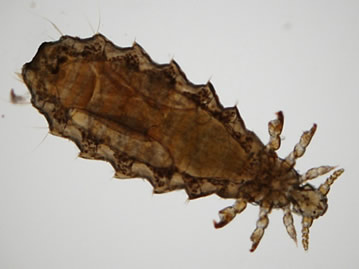Etiology: Polyplax spinulosa is the sucking louse of rats.
Incidence: Incidence of infection is uncommon. Lice are generally species-specific.
Transmission: Transmission occurs by direct contact and mutual grooming.
Distribution: First stage nymphs have a whole body distribution. Later stages are found primarily on the forebody.
Clinical Signs: Clinical signs include an unkempt appearance, pruritis and anemia with heavy infestations. This louse has been implicated as a vector of Eperythrozoon muris.
Diagnosis: The same diagnostic methods which are used to diagnose mites can be used for lice. Lice are larger than mites. These lice are Anoplurans (blood-suckers), so they may be blood-engorged.
Diagnostic Morphology: Polyplax spinulosa is a slender louse with pentagonal head that is narrower than the thorax, 7 lateral plates, and equal setae on the 4th lateral plate.
